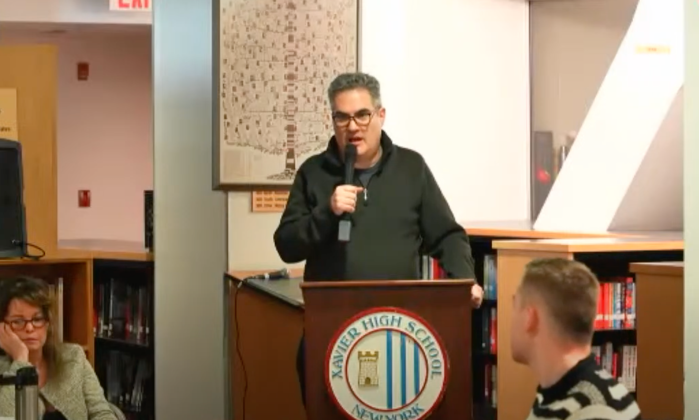Parents and students in Clinton-Hell’s Kitchen face a school overcrowding situation that will see four times as many elementary-age children in the neighborhood as there are seats to accommodate them, according to a report released by State. Sen. Thomas Duane.
Duane, who gathered with other elected officials outside PS 111 at 53rd St. and 10th Ave. on Tues., Aug. 11, called on the city to plan for the absorption of an expected 1,350 more schoolchildren over the next decade.
His report, done in conjunction with Community Board 4, analyzed information received by the Department of City Planning for pending residential construction in the neighborhood, generally bounded by 34th and 59th Sts. from Eighth Ave. to the Hudson River. The report found 26 new residential developments planned or under construction in the area, which will produce 11,259 units, including development on the western portion of the Hudson Rail Yards and another high-rise on 11th Ave.
“Failure to plan could be a recipe for disaster that would dwarf what we have been seeing in Greenwich Village, the East Side and parts of the Upper West Side,” Duane said at the press conference. “We are sounding the alarm now, and we are inviting all parties to work toward a solution.”
Using City Planning’s conservative formula for calculating incoming students—0.12 elementary-age children for each unit built—the report estimated that the new developments will bring approximately 1,350 students to Clinton-Hell’s Kitchen by 2019.
According to Duane, the planned expansion of PS 51 on W. 45th St. and existing excess capacity at PS 111 will only provide seats for an additional 324 students—leaving more than 1,000 students without seats.
“If we do not plan for the future of our schools in Clinton-Hell’s Kitchen, we will face significant overcrowding that will pit parents and children against each other in vying for the scarce number of classroom seats,” City Council Speaker Christine Quinn said the press conference. “The Department of Education must recognize this growing neighborhood and must plan accordingly for the increased number of students.”
In addition to the many parents, children and members of the West Side Neighborhood Alliance who attended the press conference, the area’s representatives on the state and federal level also joined in the chorus.
“For years, City Planning and the mayor have been working to help developers build housing for a population boom in Manhattan,” said Assemblymember Richard Gottfried. “Didn’t someone in City Hall tell the Department of Education they need a lot more classrooms and desks? City Planning and the Department of Education are both mayoral agencies. They should be paying attention to each other, and responding.”
Congressmember Jerrold Nadler and Upper West Side representatives Assemblymember Linda Rosenthal and Councilmember Gale Brewer also decried the ratio of new buildings to school seats, while Manhattan Borough President Scott Stringer warned of a citywide seat shortage.
“Community Board 4’s schools are part of a pattern we see developing around the city,” said Stringer, who issued two reports last year examining school overcrowding that specifically cited explosive growth on the West Side. “Every elementary and intermediate school in this neighborhood has seen increased enrollment in the last two years, and school construction has not kept pace with the influx of families.”
Yetta Kurland, who is challenging Quinn for her District 3 Council seat—which covers Clinton-Hell’s Kitchen—put out a separate statement a day earlier calling overdevelopment in the neighborhood the root cause of the problem.
“Didn’t we learn from the crisis in school overcrowding earlier this year?” Kurland said, also pointing out the new developments’ negative impacts on traffic and small business stability. “These luxury high-rises will eclipse and overwhelm PS 51 nearby. The school operated last year at overcapacity. Plans for a new school do not address the problems that will come with thousands of families in the proposed development, let alone resolve the current crisis with overcrowding.”































